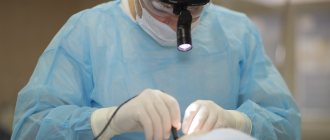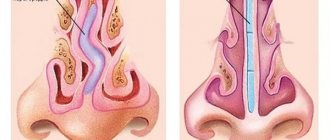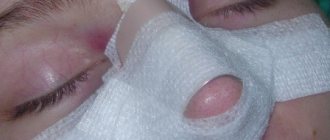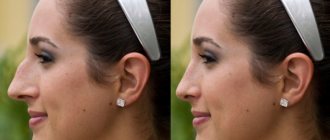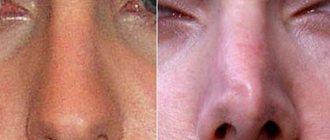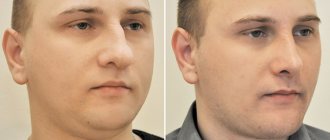Rhinoseptoplasty is a surgical correction of the shape of the nasal septum, which allows the patient to relieve some breathing problems and give his nose a more aesthetic appearance.
A deviated nasal septum is the result of anatomical developmental abnormalities or trauma to the cartilage and bones of the nose. If the septum is deformed severely enough, then such a defect can lead to:
- pathologies of nasal breathing function;
- frequent occurrence of allergic rhinitis;
- chronic inflammatory processes in the nasal cavity;
- lack of oxygen supply to the blood, which is manifested by an increase in blood pressure and vascular diseases;
- night sleep disorders;
- changes in voice timbre, speaking “in the nose”;
- psychological discomfort due to dissatisfaction with one’s own appearance.
The most effective and comprehensive way to get rid of all of the above problems is surgery on the nasal septum, designed to correct its shape.
What is septoplasty
Septoplasty
- surgery to correct a deviated nasal septum. Deviation can develop during the growth of the bone and cartilaginous parts of the nasal septum and as a result of trauma to the nose.
When breathing through the nose, the air in the nasal cavity is moistened, warmed, and disinfected (the mucus produced by the cells of the nasal mucosa has a bactericidal effect). Small villi - cilia of the ciliated epithelium on the nasal mucosa ensure the removal of various biologically active agents: bacteria, viruses, toxins. Thus, humidified, warmed, and disinfected air enters the lower respiratory tract and the cavity of the paranasal sinuses. When the nasal septum is deviated, these functions may be impaired due to improper passage of the air stream.
Experts' opinion
Some doctors are skeptical about procedures such as rhinoplasty and urge patients not to trust advertising.
Another specialist is less categorical. Perhaps because he knows firsthand about working with lasers. He notes that this method is commonly used for certain medical conditions. At the same time, the surgeon advises patients to pay attention to other features of rhinoplasty.
Indications for surgical treatment
Indications for surgery:
- difficulty breathing through the nose
- development of chronic rhinitis
- recurrent purulent sinusitis
- recurrent nosebleeds (if the cause of the bleeding is a deviated nasal septum). When an air stream hits a curvature, irritation and atrophy of the mucous membrane gradually develops in this area.
- development of cysts in the paranasal sinuses
- development of polypous processes in the sinuses (treatment is necessary to eliminate the mechanical barrier to the passage of medicinal substances into the sinuses)
To determine whether surgical treatment is required in your case, the doctor will conduct instrumental studies (endoscopic examination of the nasal cavity, computed tomography of the paranasal sinuses) to exclude pathology, as well as laboratory research methods to exclude the allergic and infectious nature of difficulty in nasal breathing.
Side effects
Even low-traumatic laser surgery can be accompanied by complications: the appearance of edema, hematomas, suture dehiscence and bleeding. To prevent this from happening, choose your clinic and doctor carefully. Follow all recommendations regarding the recovery period. Repeated surgery may be necessary if the patient is dissatisfied with the result or has difficulty breathing, etc.
By the way. According to experts, complications after laser correction are observed less frequently than after traditional rhinoplasty.
Types of septoplasty
Radio wave septoplasty
Radio wave septoplasty
– the most gentle type of surgical intervention, since the excision occurs in the nasal cavity on the mucous membrane, thanks to this it becomes possible to avoid scars. The advantages of the operation are not only aesthetics, but also the fact that the postoperative period takes less time. In terms of time, radio wave septoplasty takes no more than one hour along with preparation for the operation. During septoplasty, the surgeon removes only those parts of the nasal tissue that do not allow the nasal cavity to function normally, so in most cases the integrity of the nasal septum remains unchanged.
Laser septoplasty
Laser septoplasty
performed by equipment that creates a laser beam.
This type of operation produces a great antiseptic effect, so the likelihood of infection or complications during and after the operation is as low as possible. The rehabilitation period passes quite quickly. Laser septoplasty takes no more than half an hour, and hospital stay is no more than a day. But with all the advantages of this procedure, it has a large list of contraindications. You should consult your doctor. Comparative characteristics of radio wave and laser septoplasty
| Radio wave septoplasty | Laser septoplasty | |
| What is used | Surgitron device Videoendoscope | Laser ray Video endoscope |
| Operation duration | Within an hour (depending on the complexity of the curvature). | No more than half an hour |
| pros | The most gentle method Avoiding scars (only curved sections of the septum are removed, the curved cartilage is corrected and returned to its place in a corrected form). Maintaining the integrity of the septum Short rehabilitation period | Great antiseptic effect Short rehabilitation period Short operation time Shortest duration of hospital stay in the postoperative period Shortest duration of hospital stay in the postoperative period (1 day). |
| Minuses | Longer hospital stay | Correction of curvature using a laser is only possible in the cartilaginous part of the nasal septum. Therefore, the method is used much less frequently. Multiple contraindications. |
| Staying in hospital | 3 days | 1 day |
Preparation
An operation to correct the nasal septum requires certain preparatory measures.
First of all, the patient should come to an appointment with the attending physician, who will examine the affected area, identify the severity of the problem and give a referral for a diagnostic examination.
A week before the expected date of correction, the patient must undergo a general urine and blood test, a blood test for sugar, coagulation, syphilis, hepatitis and HIV, group and Rh factor.
Laser correction of nasal septum
The process of correcting the nasal septum with a laser is called laser septoplasty.
If surgery is prescribed for a woman, a pregnancy test must be done.
It is also necessary to do an electrocardiogram and fluorography.
If the examination results confirm the absence of contraindications and the presence of significant indications, the specialist will give recommendations on further preparation for surgery.
No later than 7 days in advance, you need to eliminate smoking and drinking alcohol from your life. Women will need to refrain from applying decorative cosmetics to their faces and performing any cosmetic procedures.
Why can our articles be trusted?
We make health information clear, accessible and relevant.
- All articles are checked by practicing doctors.
- We take scientific literature and the latest research as a basis.
- We publish detailed articles that answer all questions.
During the preparatory period, it is prohibited to eat food and take medications that have a negative effect on blood clotting. Citrus fruits, chocolate and other sweets should be excluded from the diet.
A light dinner is allowed the night before surgery. On the day of the procedure, you should not eat or drink, since it must be done on an empty stomach.
If the patient experiences psycho-emotional stress, a sedative can be taken.
How is the operation performed?
The goal of surgical treatment is to remove the cartilaginous and bone deviated parts of the nasal septum. The curved sections of the cartilage are further remodeled, as a result of which they become straight and, in this form, are re-implanted back between the layers of the mucous membrane.
During the operation, our clinic uses the Surgitron radio wave apparatus to reduce tissue bleeding.
If there is a curvature only in the area of the cartilaginous part of the nasal septum, the operation can be performed using a laser.
The advantage of the operation in our clinic is the least trauma to tissues, removal of only the curved parts of the nasal septum, and reimplantation of the corrected sections of cartilage back.
Other ways to correct the shape of the nose
An alternative to laser surgery is traditional rhinoplasty, which is performed using a scalpel, as well as injection correction with hyaluronic acid (fillers). The first method is universal; it allows you to correct various defects, including those associated with injuries.
Rhinoplasty using a scalpel is suitable even in cases where the laser procedure is powerless (extensive surgery, complex work with bones, etc.).
Non-surgical correction with fillers is the fastest method of correcting the shape of the nose. It can be done at a cosmetology clinic. Thanks to several injections, the nose will become smoother, more symmetrical, the bumps and depressions on it will disappear, and the tip will take on a new shape.
However, it will not be possible to reduce the size or change the shape of the most prominent part of the face using fillers. In addition, injection rhinoplasty is the most short-lived of all correction options. It is likely that after a few years you will have to visit a cosmetologist for repeated procedures.
By the way. If necessary, doctors combine laser and traditional rhinoplasty.
Consequences
The success of the operation depends on the qualifications and experience of the specialist. Choose your surgeon carefully.
- Natural consequences include bruising and bruising under the eyes, which subside within a week.
- Headaches and dry mucous membranes are possible.
- Scars are usually not noticeable. Visible scars can be removed with cosmetic surgery.
The septum remains straight throughout your life . No additional actions are required if you take care of your nose, avoid injuries, heavy physical exertion, and mechanical damage.
Patient reviews
Traditional rhinoplasty with a scalpel is often required in complex cases. When the patient only needs to slightly correct the shape or size of the nose, laser surgery comes to the rescue.
Laser rhinoplasty is often performed for medical reasons. If the doctor correctly identified and diagnosed the problem, the patient overcame his fears, and the operation itself was successful - everything is resolved positively.
In an operation performed with a laser, patients are attracted by the speed of rehabilitation. This is important when you don’t have time to stay on sick leave for a long time.
The author of this review confirms: the recovery period is truly one of the positive aspects of laser nose surgery.
However, not everyone finds the rehabilitation process easy and painless. Despite her readiness for the upcoming difficulties, this woman experienced physical and psychological discomfort after surgery.
Whether to do laser rhinoplasty or not - a specialist will help answer this question in each specific case. He will consult the patient in detail, find out the reason why he wants to undergo surgery, and suggest the best ways to solve the problem. Choose a doctor responsibly so that you are pleased with the result of the work.
